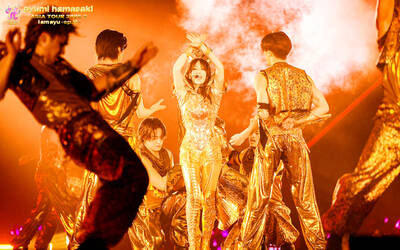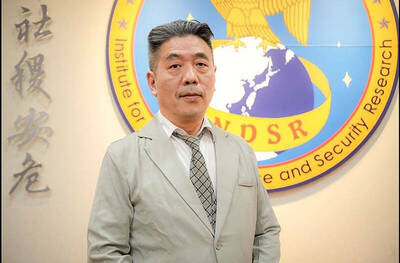A team led by National Tsing Hua University (NTHU) professors yesterday announced a breakthrough in magnetic random access memory (MRAM) semiconductor research.
MRAM is considered a better memory device than dynamic random access memory (DRAM) and static random access memory (SRAM), as it is faster and more energy-efficient, and its stored information remains intact even when it is powered down, NTHU Department of Materials Science and Engineering professor Lai Chih-huang (賴志煌) said.
MRAM works by manipulating its ferromagnetic and antiferromagnetic layers (classes of magnetic materials), but researchers have been working to make the manipulation more flexible, without having to change the MRAM’s external temperature, Lai said.

Photo: Chien Hui-ju, Taipei Times
After adding a platinum layer under the ferromagnetic and antiferromagnetic layers, the team succeeded in using a spin current caused by the flow of electrons to manipulate their “exchange bias,” a phenomenon occurring in magnetic multilayers where the antiferromagnetic layer “fixes” the ferromagnetic layer, he said.
The team is the world’s first to use a spin current to manipulate the exchange bias, resolving an obstacle that researchers have battled with for the past 60 years, he said.
Understanding spin current is vital for semiconductor development, as it has been pushed to the extreme, he said.
The team patented the technique in Taiwan, the US and China before publishing their findings in a paper titled “Manipulating exchange bias by spin-orbit torque” in the journal Nature Materials on Feb. 18, Lai said.
To verify their experiments, the team also developed techniques to measure temperature variations in microseconds, NTHU Department of Physics professor Lin Hsiu-hau (林秀豪) said.
While most scientists are still debating whether a spin current can manipulate the switching of micromagnets beyond 1 nanometer, the team has demonstrated that manipulations caused by a spin current can persist for more than several nanometers, Lin said.
After submitting their manuscript to the journal, the team spent more than one year convincing the journal’s reviewers that it was a Taiwanese team who achieved the breakthrough, despite limited funding, he added.
Funded by the Ministry of Science and Technology, the team also works with the ministry’s Taiwan Semiconductor Research Institute and other universities, Lai said.
Their technique might be used in the mass production of new MRAM devices in four or five years, Lai said, adding that they are meeting with domestic semiconductor firms to discuss a technology transfer.

Taipei and Kaohsiung have extended an open invitation to Japanese pop star Ayumi Hamasaki after Chinese authorities abruptly canceled her scheduled concert in Shanghai. Hamasaki, 47, had been slated to perform on Saturday before organizers pulled the show at the last minute, citing “force majeure,” a move widely viewed as retaliation for Japanese Prime Minister Sanae Takaichi’s recent remark that a Chinese attack on Taiwan could draw a military response from Tokyo. Taipei Mayor Chiang Wan-an (蔣萬安) yesterday said the city “very much welcomes” Hamasaki’s return and would continue to “surprise” her. Hamasaki, who has a large global fan base, including

Starting next month, people who signed up for the TPass 2.0 program can receive a 15 percent rebate for trips on mid to long-distance freeway buses or on buses headed to the east coast twice every month, the Highway Bureau said. Bureau Director-General Lin Fu-shan (林福山) said the government started TPass 2.0 to offer rebates to frequent riders of public transportation, or people who use city buses, highway buses, trains or MRTs at least 11 times per month. As of Nov. 12, 265,000 people have registered for TPass 2.0, and about 16.56 million trips between February and September qualified for

The year 2027 is regarded as the year China would likely gain the capability to invade Taiwan, not the year it would launch an invasion, Taiwanese defense experts said yesterday. The experts made the remarks after President William Lai (賴清德) told a news conference on Wednesday that his administration would introduce a NT$1.25 trillion (US$39.8 billion) special defense budget bill to boost Taiwan’s overall defense posture over the next eight years. Lai said that Beijing aims for military unification of Taiwan by 2027. The Presidential Office later clarified that what Lai meant was that China’s goal is to “prepare for military unification

‘REGRETTABLE’: Travelers reported that Seoul’s online arrival card system lists Taiwan as ‘China (Taiwan),’ the Ministry of Foreign Affairs said The Ministry of Foreign Affairs yesterday urged South Korea to correct the way Taiwan is listed in its newly launched e-Arrival card system, saying the current designation downgrades the nation’s status. South Korea rolled out the online system on Feb. 24 to gradually replace paper arrival cards, which it plans to phase out by next year. Travelers must complete the electronic form up to 72 hours before entering the country. The ministry said it has received multiple complaints from Taiwanese travelers saying that the system lists Taiwan as “China (Taiwan)” in dropdown menus for both “place of departure” and “next